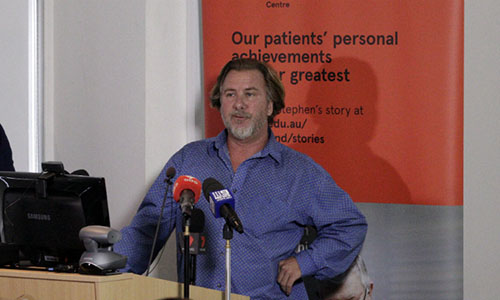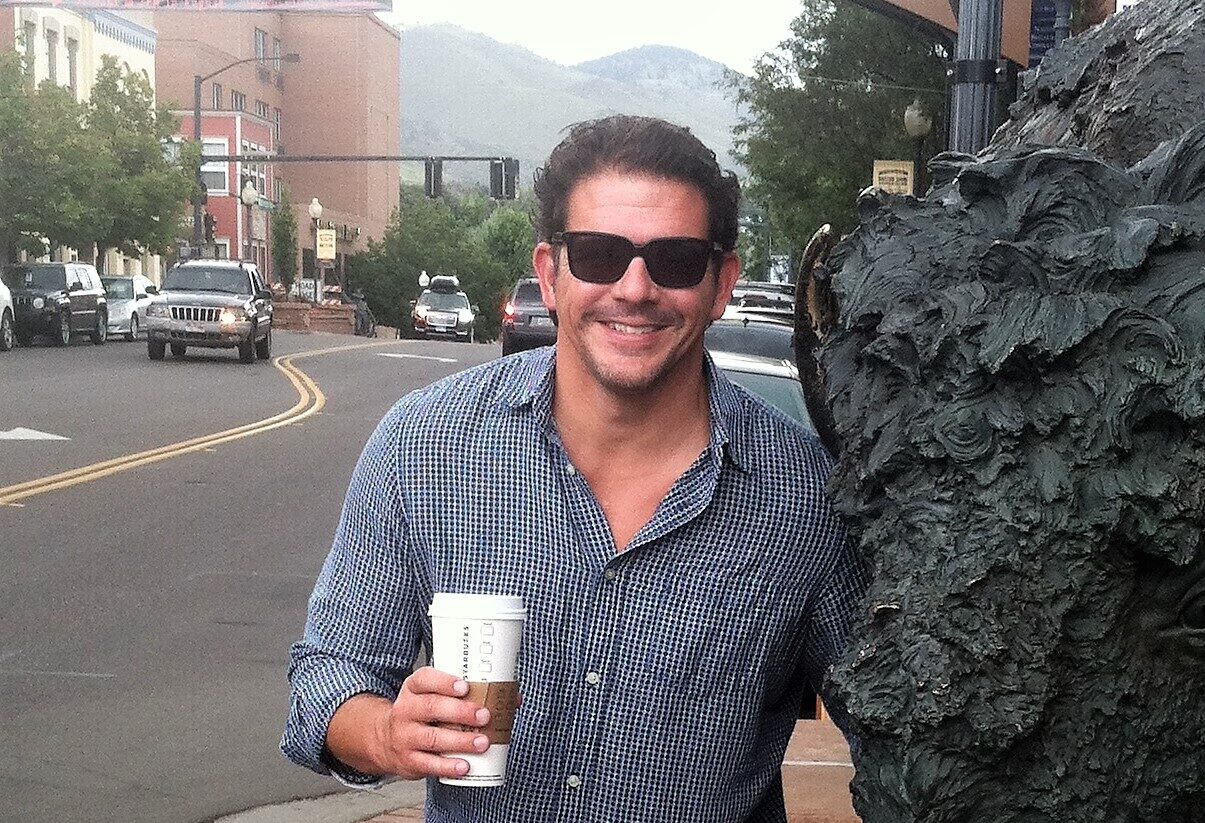Barry “Tizza” Taylor was a legendary rugby player and coach in Australia. Towards the end of his coaching career, Taylor began showing signs of impairment. He became erratic, volatile, paranoid, and became someone his family did not recognize. He was diagnosed with Alzheimer’s Disease before he passed away at 77 in 2013. After his death, his family donated his brain to the UNITE Brain Bank where researchers diagnosed him with Chronic Traumatic Encephalopathy (CTE). Taylor was the first Australian athlete diagnosed with CTE. After this diagnosis, his family helped start the Australian Sports Brain Bank, part of CLF’s Global Brain Bank.

On March 24, 2018, Steven Taylor, the son of legendary Australian rugby player and coach Barry “Tizza” Taylor, spoke at the launch of the Australian Sports Brain Bank in Sydney, Australia. His father’s Chronic Traumatic Encephalopathy (CTE) diagnosis, made by researchers at the UNITE Brain Bank in 2014, was considered a “wake-up call” for the Australian sports community. Steven spoke of his father’s glory years, how the degenerative brain disease affected him, and what his father’s legacy will be. Below is the transcript of Steven Taylor’s speech:
Steven Taylor talking about his father’s Legacy.
Over 4 years ago, I was sitting on a lounge with Dr. Ann McKee in a Conference Centre in Richmond, Virginia and she said, “I’ve held your father’s brain in my hands.” To which I replied, “I think you’re the first person that’s ever said that to me!”
A brief history of Barry Taylor
The son of an Australian Champion Boxer, living in the working class of Glebe, Dad was brought up tough… and to be tough. At 8-years-old the family moved to Manly where he became involved in swimming. He had a natural talent for sport, coupled with a strong will and in a few years, he would become a NSW and Australian Champion in Surf Life Saving.
In winter though, it was Rugby Union. He played 325 Grade games for Manly and, although he wasn’t the biggest guy on the field, he was one of the toughest, and took great pride in getting straight back into the game after a big hit. And I’m told he took quite a few.
His ability to rally and motivate people led him onto his coaching career. It was his passion, and he was good at it. He always coached the same way he played: tough. His ability to read the strategies and psychology of the game of Rugby Union and win games led him on to Coach Manly, the NSW Waratahs, the Australian Under 21’s and then on to coach internationally in Western Samoa, Japan, England and Uruguay.
Towards the end of this time overseas, Dad, in his late 50’s, began to show signs of abnormal behavior. Mum, who was always at his side, had to start covering for him. We didn’t realize that these were the first signs of dementia. After some challenging times, they returned to Australia and the madness began.
Living with CTE
So, I’m going to ask you a question. Think back to 1999. Where were you? What were you doing?
Today it is 2018. That’s 19 years, right? That’s how long Dad’s illness was. Who knows, it may have been longer. How do I try to explain what it’s like to live with someone with CTE and squash all those years into a few minutes? I’ll try.
Those of you who have experienced dementia with a loved one will have an idea of the roller coaster ride of craziness. There is no rhyme or reason to it. It moves and changes continuously, the only thing that remains constant is the steady decline, which, in dad’s case seemed to drop, then plateau for a while, drop again, then plateau, then drop, etc, etc. Sanity goes out the window, it’s confusing, frustrating, harrowing, frightening, destructive, illogical and extremely difficult to carry out a normal life. And the repetitive questions… relentless. The worrying, he must have asked Mum at least 40-50 times every night if all the lights were off, there’s no fun in it. No fun at all. Just when you thought you were on top of managing Dad’s madness, it would take off in another direction.

The Taylor family at the launch of the Australian Sports Brain Bank in March 2018.
In the beginning, it was fairly normal forgetfulness: Where are the car keys? Where did I park the car? Losing directions to somewhere he had been a thousand times, forgetting people’s names. Then the anger. Explosive moments of irrational anger, him wanting to fight, I suppose it was the internal frustration he must have felt, knowing that there was something terribly wrong going on in his mind. Dad never spoke much about his emotions even when he was well, and we never, ever spoke about it throughout his illness. Then it started getting scary. His aggression was spiraling. On one occasion we got into an argument — I can’t remember what it was about – and he had me up against a wall, with his fist clenched in a fit of rage. His eyes were crazy. This wasn’t my Dad! There were plenty of times as a young fella when I probably deserved a proper belting, but this was just craziness, it was the illness…
Fortunately, I was able to pull him down to the ground and just hold him until he calmed down. Luckily neither of us suffered any great injury. Very, very disturbing stuff. This happened more than once. So with the madness at its peak, we spoke with his GP (general practitioner) who diagnosed him with Alzheimer’s and began drug management. For some reason I didn’t think it was Alzheimer’s… I’m not sure why. One symptom of his illness at this point was paranoia; he wouldn’t take any pills because he thought we were trying to kill him. So, the doctor prescribed a drug in liquid form so it could be put in his food or a glass of water. Can you imagine having to do that?
But these drugs were way too heavy, we felt awful to see him so drugged so we set out to find a solution. Eventually we found the right balance of anti-psychotics and anti-depressants to try to give him some quality of life.
With Mum as his full time career and my sister Jenny and I doing our best to help out, the next few years were still extremely challenging and at times we were all pushed to our limits. Jenny was struggling with raising her two babies and trying to help out with caring for Dad and I unfortunately slipped into depression, which really wasn’t much help to anyone and it’s a battle that I still fight to this day. And Jenny and I have spoken since then about our own fears: Are we going to get this too? But at least Dad was now somewhat manageable, he was quite happy in his favorite chair and enjoyed short walks and drives in the car with Mum. But of course, the illness continued on its decline and eventually he lost control of his bodily functions. It was time for him to go into professional care; there was no way that Mum could possibly care for him at home any longer. She had, in my opinion, performed superhuman feats in caring for Dad and holding our family together, but it had taken its toll on her, she was mentally and physically exhausted.
We were lucky with the facility we found for Dad. Not only were the staff kind and considerate with him, they were also there for us as a family. Visiting him there was heartbreaking to say the least and the heavy feeling of guilt every time you left never got any easier. One day when I was visiting, I knew that he had already forgotten who I was, so out of curiosity I asked him what his name was.
He just looked at me and shrugged.
That’s how bad it got, he literally didn’t even know his own name. Part of the tragedy, is that his fearlessness and the physical contest of the sport he loved deprived him of a dignified old age and his family and friends of someone whom they loved. One night we got a call from the nursing home. He had finally passed away. He was 77 years old.
Closing
Peter (FitzSimons) spoke with Mum a couple of days later and after offering his condolences asked if the family would consider donating Dad’s brain to Boston University for research into CTE. We said “yes.” Dad had never been to Boston so it seemed like a good idea. As a family we are incredibly grateful to everyone involved who made it possible for Dad’s brain to make its incredible journey. It wasn’t easy, with many hurdles, but somehow it all happened. A year or so later we were invited to the Inaugural Family Huddle, a conference put on by the [Concussion Legacy Foundation] for all the families who had donated their loved one’s brains. It was fascinating to learn about the research by this wonderfully dedicated team of people into CTE, and surprisingly comforting to be amongst a group of strangers who had all been through similar experiences that we had. Swapping stories that night was such a healing experience, that we were not the only family that had gone through the horror of living with a loved one with CTE.
At the end of the evening, there I was on that lounge with Dr. Ann McKee, who performed the dissection and analysis on Dad’s brain. After telling me that she had held my father’s brain in her hands, she looked at me very compassionately and said, “I don’t know how he was functioning on any level at all, I can only imagine what you went through as a family.” I asked her if there were any markers of Alzheimer’s in her testings. She shook her head and said, “No, it was emphatically CTE that killed your father.” Finally, we had an answer to our years of questioning. Finally, we had closure.
So, we, the Taylor family, are very excited and hopeful that the Australian Sports Brain Bank will be a great success. We would like to congratulate all the people here who have worked so hard to set it up, and hope that research that can be carried out right here at home will lead to not only changes across all the sporting codes in regards to concussion, but more importantly, may lead to the ability to diagnose CTE in living patients. Perhaps then we can even find ways to treat this disease to prevent other families from going through the nightmare that we had to endure. Thank you.
To read Peter FitzSimons’ story of helping get his former coach’s brain donated after Barry Taylor died in 2013, click here.

